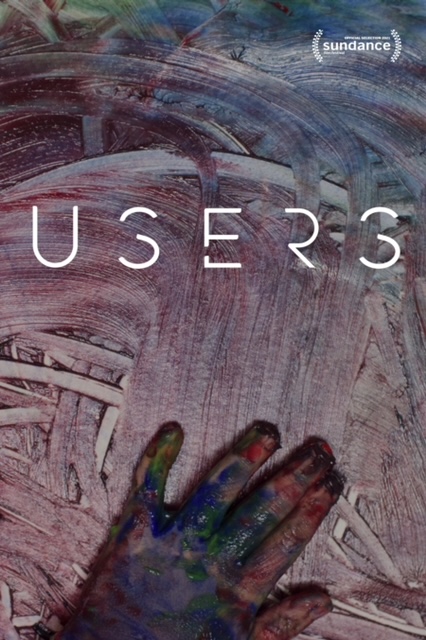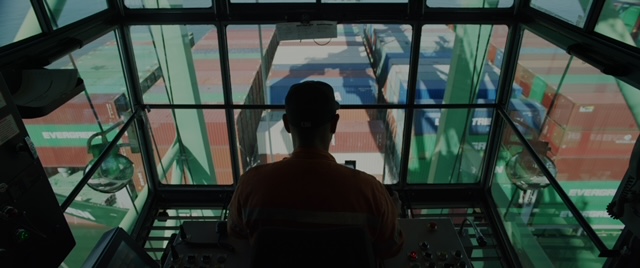An Interview with Filmmaker Natalia Almada and Sound Designer Dave Cerf
Anthropology and Documentary
Anthropology and documentary are shaped by integrating subjectivity with philosophical and ethical questions. This post draws from an interview with filmmaker Natalia Almada and sound designer Dave Cerf, a couple with two young children, about their new film, Users (2021), winner of the 2021 Sundance Documentary Directing award. In contrast to Almada’s prior films which are deeply rooted in Mexico, this cinematic documentary seems unbounded by geography, taking as its starting point a mother’s interrogation of the effects of technology on humanity and earth. This interview focuses on how the structuring choices of filming and editing afforded an opportunity to generate a novel sense of the epic nature of the domestic sphere on par with the vastness of wasteland and sea.

Promotional image for film. Image with permission by Natalia Almada.
Almada received the 2012 MacArthur “Genius” Award for her filmmaking which combines artistic expression with social inquiry. She has premiered films at Sundance, Cannes, and The New York film festivals. Her documentaries include Al Otro Lado (2005), El General (2009), El Velador (2011), and Users (2021). She directed one fiction feature film, Todo lo demás (2016). Dave Cerf works at the intersection of film editing, sound design, music, live performance, and software design. His other film soundtracks include Sam Green’s Weather Underground and Natalia Almada’s Todo lo demás.
Subjectivity as Structure
Users opens with Almada’s newborn son in a high-tech “smart” crib with her worry: will her children love their perfect machines more than their imperfect mother? From this question, Almada takes us on a journey from indoor vertical farms to wildfires to fiber optic cable landings, examining the often invisible influence of technology on our environment, relationships, bodies, and consciousness.
Schoenfeld: Were there specific books you read before making the film?
Cerf: Media theorist Neil Postman (1992) wrote six questions that he proposed that anyone developing a new technology should ask about that technology before they do it. Questions like, who benefits from this technology?
Almada: What problem are you trying to solve? Who benefits from the technology? What new problems are going to arise from fixing the problem? It really makes you think about unintended consequences. You can think of it in time. Where’s the need coming from, and then what might it cause or how might it change us in ways that we don’t foresee?
Schoenfeld: Taking on a subject like technology seems daunting. How did the medium of film itself shape those choices?
Almada: The structuring principles. When you work in the autobiographical realm, I find it a space of freedom because, by having that position of subjectivity, this mother figure, that alone can help you guide in a lot of ways, where you go. It’s my journey, not necessarily the universal, ultimate, everybody– It never claims that because it positions it as a singular. That’s important to me.
Then, we were thinking about these big areas of, “Have we looked at the environment, have we looked at something that points towards artificial intelligence and machine learning, have we looked at something that’s about social relationships and how they affect us?” We looked at these massive categories to see where the holes were. Then the other structuring principles comes more out of film- how do you build something that I wouldn’t say is a traditional story, but something that has an arc, where does your climax come and why? There are a lot of things we couldn’t film. We thought about filming lithium, but nobody knows what lithium looks like. We might be familiar with salt mines maybe and some people might know. Unless there’s a narrator there to put those things together for a lot of people, they may not know what they’re looking at. That was actually pretty challenging. Anything software-related is very hard. I wanted to get essentials, water, food, to ground the film at the beginning which is also going back to structures, to start the film in a comfortable place in a way with the things that you’re used to looking at.
Cerf: Maybe someone watching the film a thousand years ago would be able to relate to it in some way. I’ve always thought that a lot of the film, especially at the beginning, is a remembering of these basic things that have been handed down and that we relate to around the earth and nature.
Almada: And mothering, nursing, the crib, the bassinet, where we begin.
Cerf: Having a very solid foundation of evolutionarily familiar landscapes, you could read the fires as California wildfires 2018 through 2020 but there have always been these fires. Twenty years from now, people might read the film just as that and not as a particular moment in time.
The Epic Domestic
Schoenfeld: This film presents a sweeping view of humanity and technology alongside intimate domestic scenes. Can you talk about that choice?
Almada: I’ve always thought about how important subjectivity is in films. My subjectivity, who am I both in terms of gender identity, class, and who I’m filming, and who the audience is. This triangle negotiates the space in which each subjectivity and each identity is constantly at play. It’s easier to defend that position or to stake it more clearly when your subject matter is so clearly rooted in a certain place. Once that is lost, it’s hard to know how to highlight that aspect. Earlier you asked, how would you take on such a big subject matter like the technologies? Well, those big subject matters are always taken on by men, and a certain kind of men. It took a lot to say, I too am allowed to do that. I can feel entitled. Then to think, how do we speak in that epic language through a feminine or feminist perspective? What makes it a woman’s perspective? That, to me, is something you think about all the time.
Almada: Can the domestic space be epic? It usually isn’t. Rather than filming home movies of my kids, they were filmed in the same epic scale formally as technology and these other things we were looking at because the kids represent the domestic and the motherhood. To me, it’s saying who gets to choose what is epic or what those big themes in life are. Motherhood and the home and the domestic have not been included for the most part. How do we include them?
For me, very personally, having kids late because so much focus was on the career through my 30s and trying to understand, “Well, what is the relationship between career and motherhood?” When you think of who you are as what you do, to think that you might lose that is really scary, so I thought about it a lot and I felt like, moments of creativity tend to happen for me at times of change and motherhood is such a huge change. I was interested in seeing how I could take that moment of change and use it creatively and as an inspiration. Having children, it’s this opportunity to see the world differently. For me, that’s the creative impetus. The film was my experience of seeing the world as a new mother and questions that I might not have had so forefront in the past without children were suddenly front and center for me, like, what is love? We talked a lot about love when we were cutting the film and it doesn’t seem like love is part of the film, but it is because that’s our connection, that’s our bond with our kids and how does technology reinforce it or break it. That’s all it, for me, coming out of that experience of being a new mom.
Words, Images, Sounds
Schoenfeld: What do you see are some of the key differences between how ideas can get explored in film as opposed to in writing, which is the medium that most academics tend to use?
Almada: I think that writing goes to your brain first. It goes through words and it’s processed through language. Images and sound are visceral and embodied experience. You have a space for intuition that’s different or a space for an immediate response reaction to something. I always think of images as a language. You have a space for intuition that’s different or a space for an immediate response reaction. I always think of images as a language. It’s not that the images are without boundaries or without context or without perspective. I think images sometimes allow more space in the dialogue. The long duration of shots and slow pacing of the edit are intended to give space for the viewer to meander. It pushes you to the limit of boredom on purpose so that you might, in those spaces, insert your own narratives or have your own ideas and your own questions and dialogue with the film in that space.
Cerf: With our film, for example, you can close your eyes and still participate. There are repeating sonic phrases that make up a music-like composition you can engage with even if your eyes are closed. You wouldn’t be seeing the images, but you’d still be hearing the sound, you’d be getting the music. You’d be getting some of that structure.
Almada: I think almost the opposite. This film in particular asks you to work a lot. If you think of a narrator coming in to explain the film to you in language, that makes it a very passive film where you could just let it wash over you, whereas I think this film makes you work. I also feel like for me, just deciding to make films has a lot to do with growing up bi-culturally and bilingually because you develop a mistrust of language because it is so impossible to completely translate. You can make an effort at translation, but certain words just don’t work or certain ways of speaking or certain gestures of language that you have in one and not the other. When you lose that, you lose the ability to express something.
Schoenfeld: All of your other films have been set in Mexico. I’m wondering if there’s any way that those earlier work speak through this work.
Almada: I definitely see this as a continuum of the work that I’ve done. With this film, there were a lot of things that were important to me that maybe aren’t always on the forefront, but I was thinking a lot about, “Well, who’s a tech worker? Is the tech worker all those people getting on the Google bus and programming and with their high educations and high paychecks, or is your tech worker also the person who’s cleaning the office and who’s dismantling the e-waste and who’s picking the crops? To look at what a tech worker is in a way that I think is a little bit off-center which I would say comes from making films in the periphery or having that background.

Crane operator. Image from film courtesy of Natalia Almada
Users can be streamed April 21-May 5th through the DPH:DOX Copenhagen film festival and at the HotDocs Canadian Film Festival April 29th starting at 10am the film is available to watch over 48 hours.
References
Postman, N. 1992. Technopoly: The Surrender of Culture to Technology. Random House: New York.
